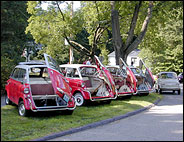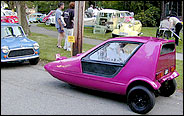|
FROM ESCAPES | DRIVING
When King Midget Ruled the Autobahn
By JIM MOTAVALLI
 n a television commercial
for the Cadillac Escalade EXT, a sport utility vehicle, two cars drive up to one empty parking space at exactly
the same time. Who's entitled to it? They solve the problem by sharing the spot — the Escalade parks, and the second
car, a tiny roadster, drives up into its cavernous cargo area. n a television commercial
for the Cadillac Escalade EXT, a sport utility vehicle, two cars drive up to one empty parking space at exactly
the same time. Who's entitled to it? They solve the problem by sharing the spot — the Escalade parks, and the second
car, a tiny roadster, drives up into its cavernous cargo area.
The second car is a 1953 Kleinschnittger F125, the creation of Paul Kleinschnittger, a German scrap-aluminum
dealer who made the cars from 1950 to 1957. It is nine and a half feet long and less than four feet wide, and it
is just one vehicle in a surprisingly large class called microcars. Tiny and efficient, they enjoyed a brief popularity
from the late 1940's to the early 60's, mostly in Europe, where conventional cars were expensive and hard to get.
Interstate-style highways and cheap subcompacts like the Austin Mini and the Volkswagen
Beetle made them obsolete.
Still, some are on the road. Nanci Maloney, an art teacher in Kansas City, Mo., drives one every day. "People
ask me if it has any safety equipment," she said. She likes to say: "No seat belts, just a bungee cord."
Her microcar of choice is the terminally cute BMW Isetta. When she first saw one at a car show, she said, "I
just started laughing hysterically." Now she has six.
Some microcars have only three wheels, and the Isetta is often mistaken for one of them because its two rear
wheels are so close together. The entire front of the car forms the only door, so the whole dashboard, including
the steering wheel, swings out to admit two passengers. The wheels are 10 inches in diameter. BMW sold 160,000
of them from 1955 to 1962, to people who didn't mind being confined to 53 miles per hour and doing without a gas
gauge. They are now a favorite of collectors.
Driving microcars in modern traffic can be hair-raising, owners say, but it's fun. Most seat two, and it's best
if the passengers are friends, but leg room is surprisingly ample. Bob Nelson, a 6-foot-2-inch state worker in
Michigan, said he tucks himself neatly into his Isetta and once gave a ride to Steve Smith, a 6-foot-8 player for
the San Antonio Spurs basketball team.
Charles Gould, a lawyer in Newton, Mass., who owns 45 microcars, compares driving one to piloting a go-cart.
"They're pretty noisy, and you sit very low to the ground on these tiny wheels," he said. "You get
all the thrills of racing without going much faster than 40 miles per hour."
The cars typically have one-cylinder engines and get up to 80 miles on a gallon of gasoline. They handle well,
especially the three-wheelers, which can pivot quickly on their single rear wheels. But they're hot, particularly
the glassed-in bubble-top models, which on sunny days leave the driver feeling like an ant under a magnifying glass.
And some, including the Kleinschnittger, don't even have a reverse gear — owners enlist a few friends and simply
turn them around.
Jim Janacek, 44, a Chicago-based television commercial producer, said people never fail to break into hearty
laughter when they encounter his Isetta at stoplights. "It's been a perfect ambassador of good will for me,"
he said.
Even the names are funny: Goggomobil, Fuldamobil, Zündapp Janus, Brutsch Mopetta, King Midget, American
Bantam, Scootacar, Crosley Hot Shot. Most models sold only a few thousand; the Kleinschnittger was typical at 2,980
(of which 100 survive). The British Peel Trident had a production run of just 50.
Scarcity and novelty have sent the prices of microcars up. They start around $1,500 for an Isetta in need of
restoration and zoom to $40,000 for a rare four-stroke Messerschmitt Tiger, but hordes of running and drivable
ones are available in the $10,000 range.
These days tiny cars are making a comeback: Mercedes-Benz's two-seat, eight-foot-long Smart car is an obvious
descendant of the microcar, though it has a three-cylinder engine.
But to those who love the classic microcars, nothing else is quite like them. "These cars are extremely
addictive," said Nanci Maloney. "When you find one that needs a good home, you just have to buy it."
|

Max Hall
BMW 600's at this year's Microcar and Minicar Classic in Brookline, Mass.

Max Hall
A Bond Bug.
|